一般现在时 一般过去时 一般将来时
- 格式:doc
- 大小:89.00 KB
- 文档页数:15
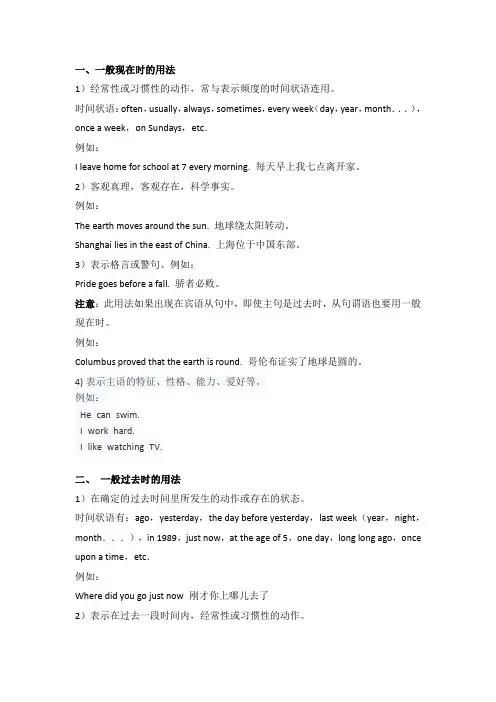
一、一般现在时的用法1)经常性或习惯性的动作,常与表示频度的时间状语连用。
时间状语:often,usually,always,sometimes,every week(day,year,month...),once a week,on Sundays,etc.例如:I leave home for school at 7 every morning. 每天早上我七点离开家。
2)客观真理,客观存在,科学事实。
例如:The earth moves around the sun. 地球绕太阳转动。
Shanghai lies in the east of China. 上海位于中国东部。
3)表示格言或警句。
例如:Pride goes before a fall. 骄者必败。
注意:此用法如果出现在宾语从句中,即使主句是过去时,从句谓语也要用一般现在时。
例如:Columbus proved that the earth is round. 哥伦布证实了地球是圆的。
4)表示主语的特征、性格、能力、爱好等。
例如:He can swim.I work hard.I like watching TV.二、一般过去时的用法1)在确定的过去时间里所发生的动作或存在的状态。
时间状语有:ago,yesterday,the day before yesterday,last week(year,night,month...),in 1989,just now,at the age of 5,one day,long long ago,once upon a time,etc.例如:Where did you go just now 刚才你上哪儿去了2)表示在过去一段时间内,经常性或习惯性的动作。
When I was a child, I often played football in the street.我是个孩子的时候,常在马路上踢足球。
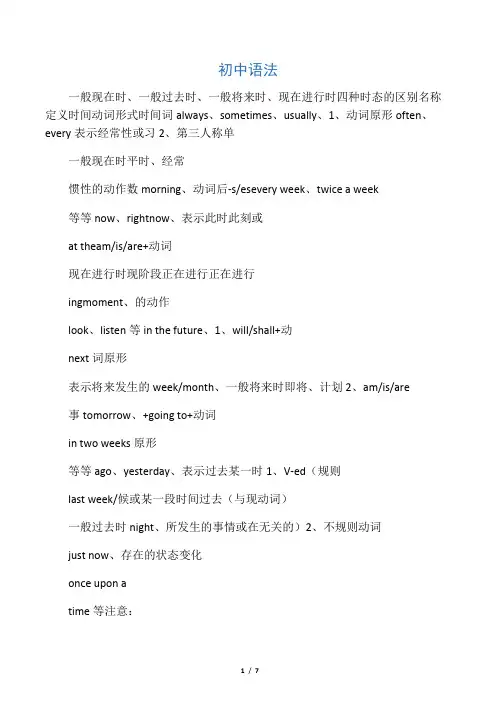
初中语法一般现在时、一般过去时、一般将来时、现在进行时四种时态的区别名称定义时间动词形式时间词always、sometimes、usually、1、动词原形often、every表示经常性或习2、第三人称单一般现在时平时、经常惯性的动作数morning、动词后-s/esevery week、twice a week等等now、rightnow、表示此时此刻或at theam/is/are+动词现在进行时现阶段正在进行正在进行ingmoment、的动作look、listen等in the future、1、will/shall+动next词原形表示将来发生的week/month、一般将来时即将、计划2、am/is/are事tomorrow、+going to+动词in two weeks原形等等ago、yesterday、表示过去某一时1、V-ed(规则last week/候或某一段时间过去(与现动词)一般过去时night、所发生的事情或在无关的)2、不规则动词just now、存在的状态变化once upon atime等注意:1、一般现在时——第三人称单数的动词变化规则:1)大多数动词在词尾加“S”如:stop-______; make-______read-______; play-______2)以辅音字母加“y”结尾的,要先将“y”变为“i”,然后在加“es”如:fly-______;carry-______study-______; worry-______3)以“s, x, ch, sh”结尾的,在词尾加“es”如:teach-______;watch-______4)以“o”结尾的动词,加“es”如:go-______do-______2、现在进行时——动词ing形式的变化规则1.一般动词直接在词尾+ing例:read→______(读)talk→______(交谈)sing→______(唱歌)2.以不发音e结尾的动词,先去e再加ing例:like→______喜欢write→______写skate→______(滑冰)3.以重读闭音节结尾且末尾只有一个辅音字母的动词,双写末尾字母,再加ing例:stop→______(停止)get→______(得到)4.少数几个以ie结尾的动词,变ie为f再加ing。
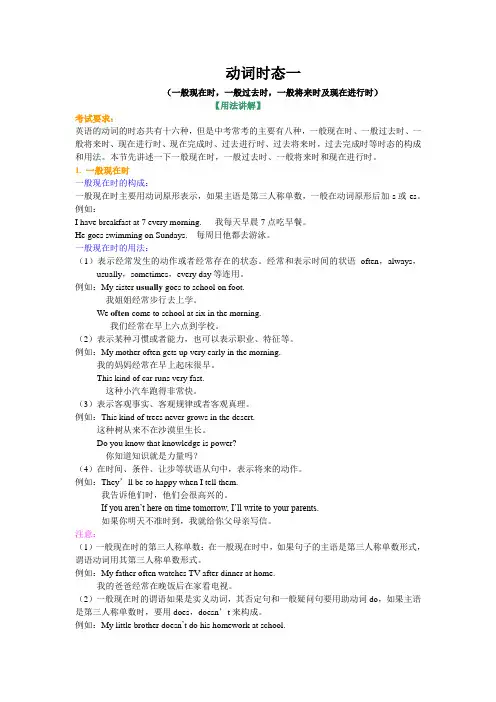
动词时态一(一般现在时,一般过去时,一般将来时及现在进行时)【用法讲解】考试要求:英语的动词的时态共有十六种,但是中考常考的主要有八种,一般现在时、一般过去时、一般将来时、现在进行时、现在完成时、过去进行时、过去将来时,过去完成时等时态的构成和用法。
本节先讲述一下一般现在时,一般过去时、一般将来时和现在进行时。
1. 一般现在时一般现在时的构成:一般现在时主要用动词原形表示,如果主语是第三人称单数,一般在动词原形后加-s或-es。
例如:I have breakfast at 7 every morning. 我每天早晨7点吃早餐。
He goes swimming on Sundays. 每周日他都去游泳。
一般现在时的用法:(1)表示经常发生的动作或者经常存在的状态。
经常和表示时间的状语often,always,usually,sometimes,every day等连用。
例如:My sister usually goes to school on foot.我姐姐经常步行去上学。
We often come to school at six in the morning.我们经常在早上六点到学校。
(2)表示某种习惯或者能力,也可以表示职业、特征等。
例如:My mother often gets up very early in the morning.我的妈妈经常在早上起床很早。
This kind of car runs very fast.这种小汽车跑得非常快。
(3)表示客观事实、客观规律或者客观真理。
例如:This kind of trees never grows in the desert.这种树从来不在沙漠里生长。
Do you know that knowledge is power?你知道知识就是力量吗?(4)在时间、条件、让步等状语从句中,表示将来的动作。
例如:They’ll be so happy when I tell them.我告诉他们时,他们会很高兴的。
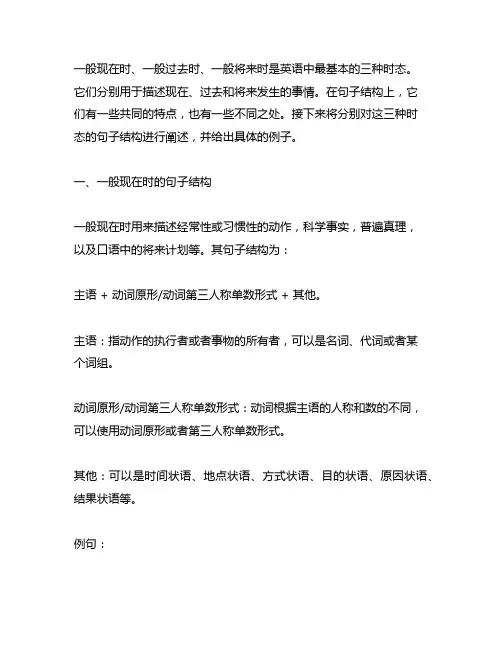
一般现在时、一般过去时、一般将来时是英语中最基本的三种时态。
它们分别用于描述现在、过去和将来发生的事情。
在句子结构上,它们有一些共同的特点,也有一些不同之处。
接下来将分别对这三种时态的句子结构进行阐述,并给出具体的例子。
一、一般现在时的句子结构一般现在时用来描述经常性或习惯性的动作,科学事实,普遍真理,以及口语中的将来计划等。
其句子结构为:主语 + 动词原形/动词第三人称单数形式 + 其他。
主语:指动作的执行者或者事物的所有者,可以是名词、代词或者某个词组。
动词原形/动词第三人称单数形式:动词根据主语的人称和数的不同,可以使用动词原形或者第三人称单数形式。
其他:可以是时间状语、地点状语、方式状语、目的状语、原因状语、结果状语等。
例句:1. I study English every day.(我每天学英语。
)2. He speaks Chinese fluently.(他讲中文流利。
)3. The sun rises in the east.(太阳从东方升起。
)二、一般过去时的句子结构一般过去时用来描述过去发生的事情或者已经完成的动作。
其句子结构为:主语 + 动词过去式 + 其他。
例句:1. I finished my homework yesterday.(我昨天完成了我的作业。
)2. She bought a new car last week.(她上周买了一辆新车。
)3. They visited the museum two days ago.(他们两天前参观了博物馆。
)三、一般将来时的句子结构一般将来时用来表示将来发生的动作或者情况。
其句子结构为:主语 + will/shall + 动词原形 + 其他。
例句:1. I will go to the cinema tomorrow.(我明天将去电影院。
)2. She shall help you with your project next week.(她下周将帮助你完成项目。
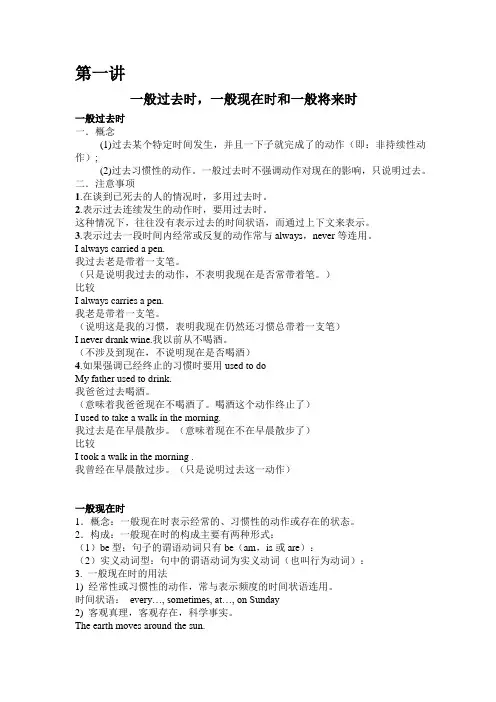
第一讲一般过去时,一般现在时和一般将来时一般过去时一.概念(1)过去某个特定时间发生,并且一下子就完成了的动作(即:非持续性动作);(2)过去习惯性的动作。
一般过去时不强调动作对现在的影响,只说明过去。
二.注意事项1.在谈到已死去的人的情况时,多用过去时。
2.表示过去连续发生的动作时,要用过去时。
这种情况下,往往没有表示过去的时间状语,而通过上下文来表示。
3.表示过去一段时间内经常或反复的动作常与always,never等连用。
I always carried a pen.我过去老是带着一支笔。
(只是说明我过去的动作,不表明我现在是否常带着笔。
)比较I always carries a pen.我老是带着一支笔。
(说明这是我的习惯,表明我现在仍然还习惯总带着一支笔)I never drank wine.我以前从不喝酒。
(不涉及到现在,不说明现在是否喝酒)4.如果强调已经终止的习惯时要用used to doMy father used to drink.我爸爸过去喝酒。
(意味着我爸爸现在不喝酒了。
喝酒这个动作终止了)I used to take a walk in the morning.我过去是在早晨散步。
(意味着现在不在早晨散步了)比较I took a walk in the morning .我曾经在早晨散过步。
(只是说明过去这一动作)一般现在时1.概念:一般现在时表示经常的、习惯性的动作或存在的状态。
2.构成:一般现在时的构成主要有两种形式:(1)be型:句子的谓语动词只有be(am,is或are):(2)实义动词型:句中的谓语动词为实义动词(也叫行为动词):3. 一般现在时的用法1) 经常性或习惯性的动作,常与表示频度的时间状语连用。
时间状语:every…, sometimes, at…, on Sunday2) 客观真理,客观存在,科学事实。
The earth moves around the sun.Shanghai lies in the east of China.3) 表示格言或警句中。
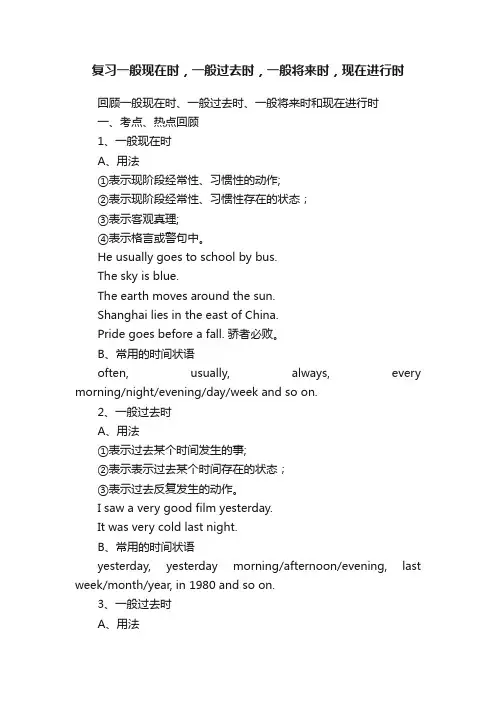
复习一般现在时,一般过去时,一般将来时,现在进行时回顾一般现在时、一般过去时、一般将来时和现在进行时一、考点、热点回顾1、一般现在时A、用法①表示现阶段经常性、习惯性的动作;②表示现阶段经常性、习惯性存在的状态;③表示客观真理;④表示格言或警句中。
He usually goes to school by bus.The sky is blue.The earth moves around the sun.Shanghai lies in the east of China.Pride goes before a fall. 骄者必败。
B、常用的时间状语often, usually, always, every morning/night/evening/day/week and so on.2、一般过去时A、用法①表示过去某个时间发生的事;②表示表示过去某个时间存在的状态;③表示过去反复发生的动作。
I saw a very good film yesterday.It was very cold last night.B、常用的时间状语yesterday, yesterday morning/afternoon/evening, last week/month/year, in 1980 and so on.3、一般过去时A、用法①表示在将来某个时间要发生的事;②表示表示在将来某个时间存在的状态;Mrs Wu will teach us English this term.I will go back to my hometown tomorrow.B、具体表现形式①助动词will+动词原形We won’t leave before eight.②be going to do sth.表示即将发生某事或打算、计划要做某事。
I’m going to do my homework this evening.③come, start,go ,move, leave, travel等动词常用进行时态表示按计划将要发生的事。
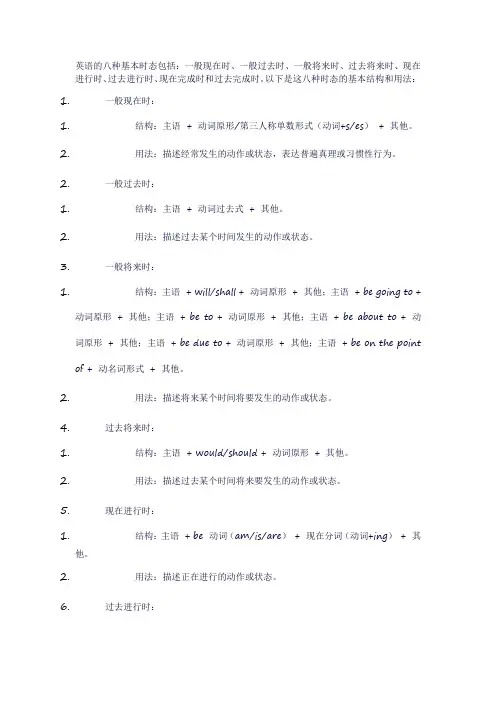
英语的八种基本时态包括:一般现在时、一般过去时、一般将来时、过去将来时、现在进行时、过去进行时、现在完成时和过去完成时。
以下是这八种时态的基本结构和用法:1.一般现在时:1.结构:主语+ 动词原形/第三人称单数形式(动词+s/es)+ 其他。
2.用法:描述经常发生的动作或状态,表达普遍真理或习惯性行为。
2.一般过去时:1.结构:主语+ 动词过去式+ 其他。
2.用法:描述过去某个时间发生的动作或状态。
3.一般将来时:1.结构:主语+ will/shall + 动词原形+ 其他;主语+ be going to +动词原形+ 其他;主语+ be to + 动词原形+ 其他;主语+ be about to + 动词原形+ 其他;主语+ be due to + 动词原形+ 其他;主语+ be on the point of + 动名词形式+ 其他。
2.用法:描述将来某个时间将要发生的动作或状态。
4.过去将来时:1.结构:主语+ would/should + 动词原形+ 其他。
2.用法:描述过去某个时间将来要发生的动作或状态。
5.现在进行时:1.结构:主语+ be 动词(am/is/are)+ 现在分词(动词+ing)+ 其他。
2.用法:描述正在进行的动作或状态。
6.过去进行时:1.结构:主语+ be 动词的过去式(was/were)+ 现在分词(动词+ing)+ 其他。
2.用法:描述过去某个时间点正在进行的动作或状态。
7.现在完成时:1.结构:主语+ have/has + 过去分词(动词+ed)+ 其他。
2.用法:描述过去发生的动作对现在造成的影响或结果,或者表示从过去某一时间开始一直持续到现在的情况。
8.过去完成时:1.结构:主语+ had + 过去分词(动词+ed)+ 其他。
2.用法:描述过去某个时间点之前已经完成的动作或状态,或者表示一个过去的动作在另一个过去的动作之前发生。
请注意,以上列出的时态结构和用法是基本的概述,实际使用中可能因语境和习惯而有所不同。
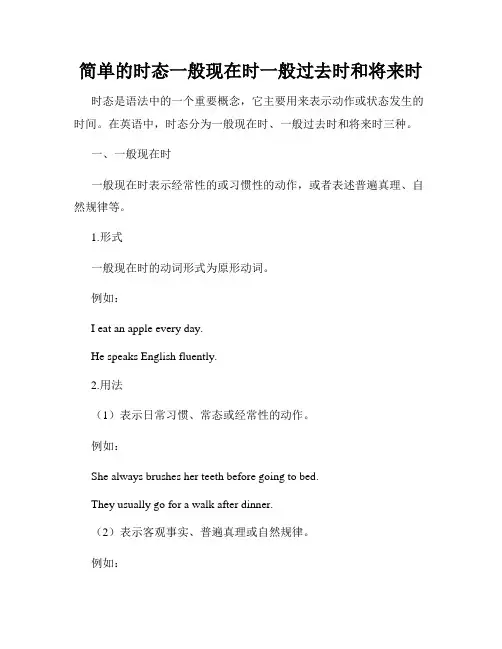
简单的时态一般现在时一般过去时和将来时时态是语法中的一个重要概念,它主要用来表示动作或状态发生的时间。
在英语中,时态分为一般现在时、一般过去时和将来时三种。
一、一般现在时一般现在时表示经常性的或习惯性的动作,或者表述普遍真理、自然规律等。
1.形式一般现在时的动词形式为原形动词。
例如:I eat an apple every day.He speaks English fluently.2.用法(1)表示日常习惯、常态或经常性的动作。
例如:She always brushes her teeth before going to bed.They usually go for a walk after dinner.(2)表示客观事实、普遍真理或自然规律。
例如:The sun rises in the east.Water boils at 100 degrees Celsius.(3)表示评论、观点或感受等。
例如:I think he is a talented musician.She looks beautiful in that dress.二、一般过去时一般过去时表示过去某个时间发生或完成的动作。
1.形式一般过去时的动词形式为动词的过去式。
例如:I studied English last night.He played basketball with his friends yesterday.2.用法(1)表示过去某个时间发生的动作。
例如:We visited the museum last week.She met her old friend at the party.(2)表示过去经常性的动作。
例如:He always ate breakfast at home when he was a child.(3)表示过去的习惯、惯常动作。
例如:Every morning, she woke up early and went jogging.三、将来时将来时表示将来某个时间发生或完成的动作。
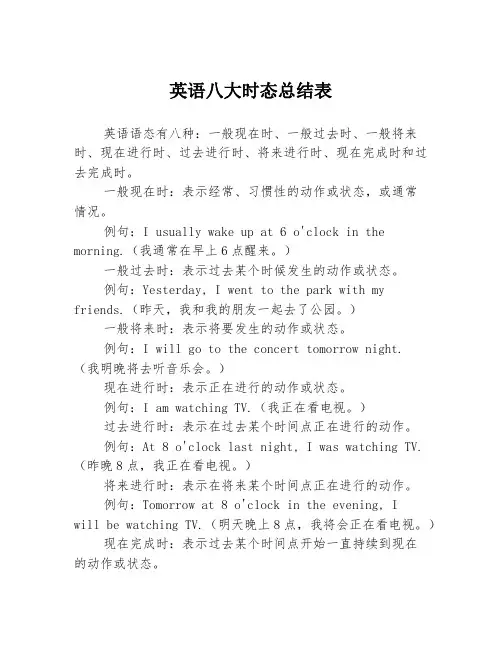
英语八大时态总结表英语语态有八种:一般现在时、一般过去时、一般将来时、现在进行时、过去进行时、将来进行时、现在完成时和过去完成时。
一般现在时:表示经常、习惯性的动作或状态,或通常情况。
例句:I usually wake up at 6 o'clock in the morning.(我通常在早上6点醒来。
)一般过去时:表示过去某个时候发生的动作或状态。
例句:Yesterday, I went to the park with my friends.(昨天,我和我的朋友一起去了公园。
)一般将来时:表示将要发生的动作或状态。
例句:I will go to the concert tomorrow night.(我明晚将去听音乐会。
)现在进行时:表示正在进行的动作或状态。
例句:I am watching TV.(我正在看电视。
)过去进行时:表示在过去某个时间点正在进行的动作。
例句:At 8 o'clock last night, I was watching TV.(昨晚8点,我正在看电视。
)将来进行时:表示在将来某个时间点正在进行的动作。
例句:Tomorrow at 8 o'clock in the evening, Iwill be watching TV.(明天晚上8点,我将会正在看电视。
)现在完成时:表示过去某个时间点开始一直持续到现在的动作或状态。
例句:I have lived in this city for 5 years.(我已经在这个城市住了5年了。
)过去完成时:表示过去某个时间点之前已经完成的动作或状态。
例句:By the time I arrived, they had already left.(我到达的时候,他们已经离开了。
)以上八种语态使用灵活,掌握好各个语态的用法,能够更好地表达自己的意思。
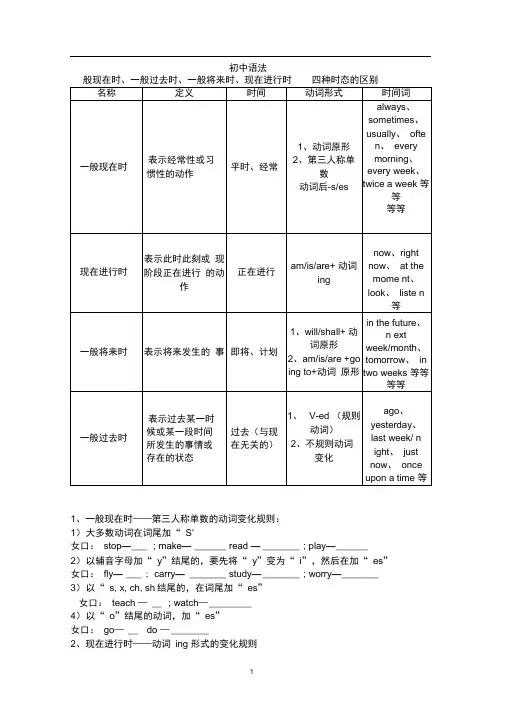
初中语法般现在时、一般过去时、一般将来时、现在进行时四种时态的区别1、一般现在时——第三人称单数的动词变化规则:1)大多数动词在词尾加“ S'女口:stop—___ ; make— ______ read — _______ ; play—______2)以辅音字母加“ y”结尾的,要先将“ y”变为“ i”,然后在加“ es”女口:fly— ___ ; carry—_______ study—_______ ; worry—_______ 3)以“ s, x, ch, sh结尾的,在词尾加“ es”女口:teach — __ ; watch—_________4)以“ o”结尾的动词,加“ es”女口:go— __ do —________2、现在进行时——动词ing 形式的变化规则1. 一般动词直接在词尾+ing例:read—______ (读) talk—_______ (交谈) sinL ______ (唱歌) 2. 以不发音e 结尾的动词,先去e 再加ing例:like—_____ 喜欢write—______ 写skate—_______ (滑冰)3. 以重读闭音节结尾且末尾只有一个辅音字母的动词,双写末尾字母,再加ing 例:stop—_____ (停止) get—__________ (得到)4. 少数几个以ie 结尾的动词,变ie 为f 再加ing。
例:l i e —___ (躺、撒谎) t i e — ___ (系、捆绑)3、一般过去时——动词的变化规则(1) 一般在动词后加-ed。
如:play- _____ , offer- _____ , weigh- _____ , destroy- _____ , sign- _____(2) 在以字母e 结尾的动词后,只加-d。
如: like - ____ , provide-_____ , hate- _____ date- ________⑶在以“辅音字母+y”结尾的动词后,则改y为i,再加-ed。
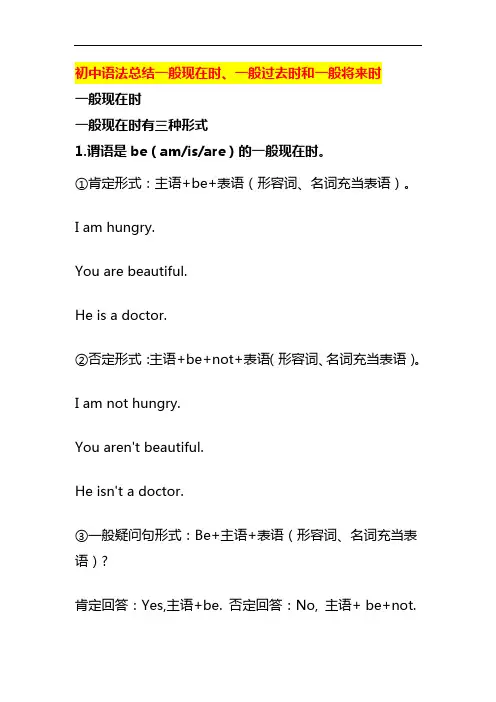
初中语法总结一般现在时、一般过去时和一般将来时
一般现在时
一般现在时有三种形式
1.谓语是be(am/is/are)的一般现在时。
①肯定形式:主语+be+表语(形容词、名词充当表语)。
I am hungry.
You are beautiful.
He is a doctor.
②否定形式:主语+be+not+表语(形容词、名词充当表语)。
I am not hungry.
You aren't beautiful.
He isn't a doctor.
③一般疑问句形式:Be+主语+表语(形容词、名词充当表语)?
肯定回答:Yes,主语+be. 否定回答:No, 主语+ be+not.
—Are you hungry?
—Yes,I am./No,I'm not.
—Is he a doctor?
—Yes, he is./No, he isn,t.
④特殊疑问句形式:特殊疑问词+Be开头的一般疑问句?
—What is he?
—He is a doctor.
注意:be要随着主语变。
2.谓语动词是实义动词(及物动词或不及物动词)的一般现在时。
①肯定形式:“主语+及物动词+宾语”或“主语+不及物动词”。
She has a little brother.
她有一个弟弟。
英文最常用的时态有五个:一般现在时;一般过去时;一般将来时; 现在进行时和现在完成时。
一、一般现在时:用动词原型表示,但单数第三人称后要加-s,在词尾加-s时要注意:1.一般情况:加-s 例:reads,writes,says 2.以s,x,ch,sh收尾的词加-es 例:teaches,washes,guesses3.以辅音字母+y结尾的词变y为i再加-es 例:try—tries,carry—carries。
这个时态的疑问句一般以句首加助动词do,does构成。
句中动词要用原型动词be提前:do you know it?are you students?does she have a pen?1.一般现在时表示经常性或习惯性的动作:we always care for each other and help each other。
they cycle to work every day。
2.现在的特征或状态:he loves sports。
do you sing?a little。
i major in english。
3.遍真理:light travels faster than sound。
two and four makes six。
the moon moves round the earth。
有些表示状态和感觉的动词常常可用于一般现在时:be,love,like,hate,want,hope,need,prefer,wish,know,understand,remember,believe,recognize,guess,suppose,mean,belong,think(以为),feel,envy,doubt,remain,consist,contain,seem,look(看起来),see,fit,suit,owe,own,hear,find,suggest,propose,allow,show(说明),prove,mind(在意),have(有),sound(听起来),taste (尝起来),matter,require,possess,desire等等。
一般现在时、一般将来时、一般过去时、现在进行时知识总结一、一般现在时一般现在时表示经常性或习惯性的动作,常与表示频度的时间状语连用,如often, usually, always, sometimes, never, seldom, every week/day/year/month..., once a week, on Sundays等。
动词用原形。
当主语为第三人称单数时(he, she, it, 一个人名),动词变为三单形式。
第三人称单数的动词变化规则:(只有在第三人称(he, she, it, 一个人名)为主语的肯定句中,动词才用三单式)(1)一般情况下,直接加s runs gets likes(2)结尾是s, x, sh, ch, o,前为辅音字母,结尾加es watches, goes, washes, crosses, mixes, does(3)动词末尾y,前为辅音,将y改为i加es study→studies fly→flies但在y前如果为元音则直接加s buys says plays(4)不规则变形have—has二、一般将来时一般将来时表示将来发生的事。
常与tomorrow, next day/week/month/year..., soon, in a few minutes, the day after tomorrow, in the future等时间状语连用。
Will/shall +动词原形;(shall用语第一人称)be(am/is/are) going to+ 动词原形三、一般过去时一般过去时表示过去某一时候或某一段时间所发生了的事情或存在的状态。
常与过去时间yesterday,ago, this morning,just now,a moment ago,last night / year / week/month,once upon a time,the other day,before,the day before yesterday, in 1989, at the age of five, one day, then(那时), on that day,in the past连用。
英语八大时态例句及解析英语八大时态包括一般现在时、一般过去时、一般将来时、过去将来时、现在进行时、过去进行时、现在完成时和过去完成时。
以下是这八大时态的例句及解析:1. 一般现在时:I have lunch at 12:00 every day.(我每天12点吃午饭。
)解析:表示经常发生的动作或存在的状态。
2. 一般过去时:She studied very hard last year.(她去年学习很努力。
)解析:表示过去发生的动作或存在的状态。
3. 一般将来时:He will come back in two days.(他将在两天后回来。
)解析:表示将来要发生的动作或存在的状态。
4. 过去将来时:They said they would go to the park the next day.(他们说第二天要去公园。
)解析:表示在过去某个时间看来将要发生的动作或存在的状态。
5. 现在进行时:They are playing basketball now.(他们现在正在打篮球。
)解析:表示正在进行的动作或存在的状态。
6. 过去进行时:She was cooking dinner when I called her.(当我打电话给她时,她正在做饭。
)解析:表示过去某个时间点正在进行的动作。
7. 现在完成时:I have finished my homework.(我已经完成了作业。
)解析:表示已经完成的动作或存在的状态,强调对现在的影响。
8. 过去完成时:They had left before we arrived.(在我们到达之前,他们已经离开了。
)解析:表示在过去的某个时间之前已经完成的动作。
希望能够帮助到您。
如需更多详细信息,建议查阅英语语法书籍或咨询英语教师。
初中英语语法:一般现在时、一般过去时和一般将来时一、一般现在时(一)一般现在时的三种形式1、谓语是be(am/is/are)的一般现在时。
①肯定形式:主语+be+表语(形容词、名词充当表语)。
I am hungry.You are beautiful.He is a doctor.①否定形式:主语+be+not+表语(形容词、名词充当表语)。
I am not hungry.You aren't beautiful.He isn't a doctor.①一般疑问句形式:Be+主语+表语(形容词、名词充当表语)?肯定回答:Yes,主语+be. 否定回答:No, 主语+ be+not.—Are you hungry?—Yes,I am./No,I'm not.—Is he a doctor?—Yes, he is./No, he isn,t.①特殊疑问句形式:特殊疑问词+Be开头的一般疑问句?—What is he?—He is a doctor.注意:be要随着主语变。
2.谓语动词是实义动词(及物动词或不及物动词)的一般现在时。
①肯定形式:“主语+及物动词+宾语”或“主语+不及物动词”。
She has a little brother.她有一个弟弟。
The sun rises in the east.太阳从东方升起。
①否定形式:“主语+don't/doesn't+及物动词+宾语”或“主语+don't/doesn't+不及物动词”。
She doesn't have a little brother.她没有弟弟。
I don't eat every morning.我每天早晨都不吃饭。
①一般疑问句形式:“Do/Does+主语+及物动词原形+宾语”或“Do/Does+主语+不及物动词原形”。
肯定回答:Yes,主语+do/does. 否定回答是:No, 主语+ don't/doesn't.—Do you eat every morning?—Yes, I do./No, I don't.—Does she have a little brother?—Yes, she does./No, she doesn't.①特殊疑问句:特殊疑问词+do/does开头的一般疑问句?What do you like?When do you go to school?注意:根据主语确定用do还是does。
5种时态:1、一般现在时;2、一般过去时:一般过去时由动词的过去式构成,即在动词原形后加ed。
例如,He was here just now. 他刚才还在这里。
What did you do yesterday? 你昨天做了什么事?3、一般将来时;will,be gong to4、现在进行时;be+V-ing5、现在完成时:has/have+V-en(动词的过去分词),它和一般过去时的区别就在于,现在完成时主要表示,发生在过去的动作延续到现在刚刚完成、或许还要延续,或者就是过去的动作对现在可以产生影响;例如By now, I have collected all the data that I need .到现在为止,我已收集到了我所需的全部资料。
You have grown much taller.你长高了许多。
被动语态:be 动词+V-en(动词的过去分词)(你说的是对的,呵呵)特殊情况:1、情态动词后面+be+过去分词(V-en)should be +过去分词(V-en)must be +过去分词(V-en)can be +过去分词(V-en)2、进行时态的被动is/are +being +过去分词(V-en)(表示此时此刻某事正在被做。
)3、过去时的被动was+being +过去分词(V-en)(过去进行时)had +been +过去分词(V-en)(过去完成时)(这个貌似你们还没学到)was +过去分词(V-en)(一般过去时)(这个就是你今天说的那个语态,是对的。
)总结一下啊:被动语态的基本结构先记住,be 动词+V-en(动词的过去分词),然后在这个基础之上,如果有其他时态的话,再做修改。
比如,今天讲的那个题,电视机由谁谁发明,本来应该是is invented,因为他是过去呗发明的,应该用一般过去时,所以就要把is改为过去式was; 再举个例子啊,The sports meeting is being held in our school. 我校正在举行运动会。
教学内容知识点一:一般现在时【知识梳理】(1)一般现在时的基本结构和变化1.一般现在时的结构①be动词:主语+be(am, is, are)+其它。
e.g. I am a boy.我是一个男孩。
②行为动词:主语+行为动词(+其它)。
一般现在时主要用动词的原形表示,如果主语是第三人称单数,则在动词原形后加"-s"或"-es"e.g. He gets up early in the morning.2.否定句和疑问句的变化①be动词的变化:A.否定句:主语+ be + not +其它。
He is not a worker.他不是工人。
B. 一般疑问句:Be +主语+其它。
---Are you a student? ---Yes. I am. / No, I'm not.C. 特殊疑问句:疑问词+一般疑问句。
Where is my bike?②行为动词的变化:A.否定句:主语+ don't( doesn't ) +动词原形(+其它)。
I don't like bread. / He doesn't like bread.B. 一般疑问句:Do ( Does ) +主语+动词原形+其它。
---Do you often play football? --- Yes, I do. / No, I don't.--- Does she go to work by bike? --- Yes, she does. / No, she doesn't.C. 特殊疑问句:疑问词+一般疑问句。
How does your father go to work?(注意回顾动词第三人称单数形式变化规则)一般情况下在词尾加s help→helps, clean→cleans, play→plays, wear→wears, give→gives; 以s, x, ch, sh结尾的动词在词尾加es dress→dresses, fix→fixes, watch→watches, finish→finishes;以“辅音字母加y”结尾的动词,把y变为i,再study→studies, carry→carries, fly→flies )(2)一般现在时的用法•1.表示经常性或习惯性的动作或行为。